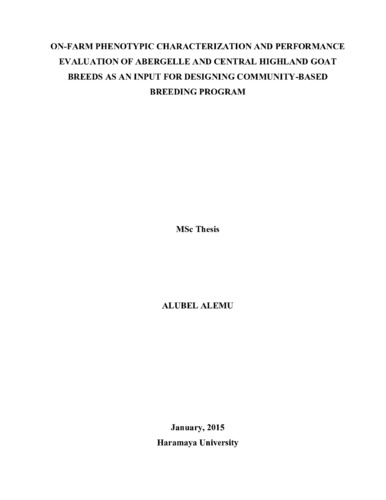On-farm phenotypic characterization and performance evaluation of abergelle and central highland goat breeds as an input for designing community-based breeding program
Abstract
The objectives of this study were to describe the production environment and production systems, characterize (phenotypic) and evaluate on-farm performances of Abergelle and Central Highland goat breeds. A total of 256 farmers in Ziquala (68), Tanqua Abergelle (70) and Lay- Armachiho (118) districts were interviewed for the household survey. Data for qualitative and quantitative characters were collected from a total of 640 4PPI age category goats (143 from Ziquala and 183 from Tanqua Abergelle districts on Abergelle goat breed and 314 from Lay Armachiho district on Central Highland goat breed). Base flock, flock dynamics, birth and growth weight, milk yield data recordings were taken from mid July 2013 up to mid August 2014 for on-farm performance evaluation. Data collected through questionnaire (survey) were described by descriptive statistics using SPSS. Observations on qualitative traits were analyzed for male and female goats separately using frequency procedure of SAS. Whereas, quantitative traits were analyzed using the GLM procedures of SAS. Individual interviews and group discussions made in all of the three districts indicated that all of the farmers practiced both crop and livestock production. The first objective of keeping goat in all districts was to get cash income. Unlike Lay Armachiho district, all goat keepers in Ziquala and Tanqua Abergelle districts reported that they milk their goats. From the current survey result milk yield (mean±SD)/doe/day (liter) in the rainy and in the dry seasons in Ziquala district were 0.43±0.24 and 0.15±0.14 respectively. The corresponding values for Tanqua Abergelle district were 0.48±0.24 and 0.19±0.29 respectively. The actual on-farm milk yield (mean±SE) monitoring result in Ziquala district in wet and dry seasons were 285.42±5.64 and 243.12±9.92 milliliter/doe/day respectively. The corresponding values for Tanqua Abergelle district were 452.68±6.15 and 362.03±9.19 milliliter/doe/day respectively. Communal natural pasture and river water were the major sources of goat feeding and watering respectively both in dry and wet seasons in each of the three districts. Among the interviewed goat keepers in the study districts 97.1% in Ziquala, 98.7% in Tanqua Abergelle and 66.8% in Lay Armachiho had their own indigenous breeding male goat. Coat color, body conformation and growth rate were the first, second and third selection criteria for breeding buck respectively in Ziquala and Tanqua Abergelle districts. The corresponding values for Lay Armachiho district were body conformation, growth rate and coat color. The first preferred trait for does was milk yield in Ziquala and Tanqua Abergelle districts and body conformation in Lay Armachiho district. Drought, disease and feed shortage were the first, second and third major constraints respectively for goat production in Ziquala and Tanqua Abergelle districts. The corresponding values for Lay Armachiho district were disease, theft and predator. Majority of Abergelle goat coat color was brown/red (30.40%) and its combination with other coat colors (50.61%), whereas relatively high proportion of Central Highland goat had white coat color (21.66) and its combination with other coat colors (55.09 %). There were very high significant differences (at least P<0.01) across breeds in all body measurements except (p>0.05) rump length and pelvic width. From all the measurements compared, Central Highland goat had higher values except rump length, pelvic width and horn length. In general, males showed higher measurements than females and the interaction between sex and breed significantly (at least p<0.05) affected all the parameters measured. Least square means (±SE) of body weight (kg) for Abergelle males and females at 4PPI were 30.75±0.60 and 24.30±0.32 respectively. The corresponding values for Central Highland goats were 34.79±0.73 and 33.11±0.31 respectively. The average flock size per monitored households in Ziquala, Tanqua Abergelle and Lay Armachiho districts were 27.33±1.88, 19.18±1.32 and 13.79± 9.41 goats respectively. The overall least square means (±SE) for birth, three, six and nine month weights (kg) of Abergelle goat kids at Ziquala district monitoring site were 1.98± 0.06, 7.30± 0.21, 9.25±0.31 and 11.21±0.53 respectively. For the same breed at Tanqua Abergelle district monitoring site for the above age categories (in kg) were 1.97± 0.06, 7.43± 0.23, 11.08±0.33 and 13.24±0.55 respectively. The corresponding values for Central Highland goats in Lay Armachiho district monitoring site were 2.31±0.04, 10.67± 0.17, 17.53±0.24 and 22.66±0.44 respectively. As recommendation, further cluster studies should be conducted on Central Highland goat breed for the uniformity or dissimilarity of goats for the areas delineated by FARM Africa (1996). Abergelle goat keepers traditionally believe that ‘liybia’ goat is prolific and productive due to especial gene it has. This traditional knowledge should be scientifically proved or disproved whether this goat genetic makeup is significantly different or similar with other ordinary goats in the same goat breed.

